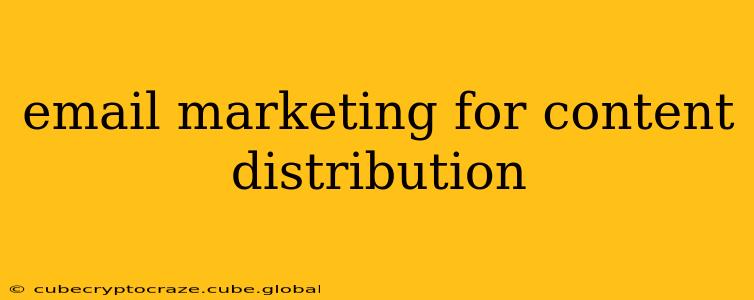Email marketing remains a potent tool for content distribution, offering a direct line of communication to your target audience. Unlike social media, where algorithms dictate visibility, email allows you to control the message and ensure your content reaches your subscribers' inboxes. This guide explores effective strategies for leveraging email marketing to maximize your content's reach and impact.
Why Email Marketing for Content Distribution?
In today's digital landscape, email marketing provides several key advantages for distributing your content:
- High Engagement Rates: Email boasts significantly higher engagement rates than many social media platforms. Subscribers have explicitly opted in to receive your communications, indicating a higher likelihood of interaction.
- Targeted Reach: Email allows for precise targeting based on demographics, interests, and behavior. This ensures your content reaches the most receptive audience segments.
- Measurable Results: Email marketing platforms offer robust analytics, enabling you to track open rates, click-through rates, and conversions, providing valuable insights into campaign performance.
- Cost-Effectiveness: Compared to other marketing channels, email marketing offers a relatively low cost per acquisition, making it a highly efficient strategy.
- Building Relationships: Consistent, valuable email communication fosters stronger relationships with your audience, building brand loyalty and advocacy.
How to Use Email Marketing for Content Distribution Effectively
Here's a breakdown of key strategies to maximize the effectiveness of your email marketing efforts for content distribution:
1. Segment Your Audience:
People Also Ask: How do I segment my email list?
Segmenting your email list involves dividing your subscribers into smaller groups based on shared characteristics, such as demographics (age, location), interests (specific topics), or behavior (past purchases, website activity). This allows for personalized content delivery, leading to higher engagement. You can segment using your email marketing platform's built-in features, often based on tags or custom fields you create during signup. For example, you might have segments for "Beginner Blog Readers," "Advanced Marketing Professionals," or "Customers Who Purchased Product X." Effective segmentation is crucial for maximizing the impact of your content distribution.
2. Create Compelling Subject Lines:
People Also Ask: What makes a good email subject line?
Your subject line is the gateway to your content. It needs to be concise, compelling, and relevant to your subscribers' interests. A/B testing different subject lines helps you identify what resonates best with your audience. Consider using numbers ("5 Tips to…"), questions ("Are You Making This Mistake?"), or creating a sense of urgency ("Don't Miss Out!"). Always avoid spammy keywords and misleading information.
3. Design Engaging Emails:
People Also Ask: How do I design an effective email for content distribution?
The design of your email is crucial for engagement. Use a clean, visually appealing layout, with clear calls to action (CTAs). Incorporate high-quality images or videos to enhance the visual appeal of your content. Keep the text concise and easy to read, using bullet points and subheadings to break up large blocks of text. Ensure your email is mobile-friendly, as many subscribers open emails on their smartphones.
4. Promote a Variety of Content:
People Also Ask: What type of content should I send in my emails?
Don't limit yourself to just blog posts. Diversify your content to keep your audience engaged. Promote case studies, webinars, infographics, videos, podcasts, and other relevant materials. This showcases your expertise and caters to different learning styles and preferences.
5. Optimize for Deliverability:
People Also Ask: How can I improve my email deliverability?
High deliverability ensures your emails land in subscribers' inboxes, not spam folders. Maintain a clean email list by regularly removing inactive subscribers. Use a reputable email marketing platform that adheres to best practices. Avoid spam triggers such as excessive capitalization, excessive use of exclamation points, and misleading subject lines. Regularly monitor your email statistics to identify and address any deliverability issues.
6. Track and Analyze Your Results:
People Also Ask: What email marketing metrics should I track?
Regularly analyze your email campaign performance to optimize your strategy. Key metrics include open rates, click-through rates, conversion rates, and unsubscribe rates. Use this data to refine your content, subject lines, and email design for better results.
By implementing these strategies, you can transform your email marketing from a simple announcement system into a powerful engine for content distribution and audience engagement. Remember, consistency and value are key to building a loyal subscriber base and fostering long-term success.
